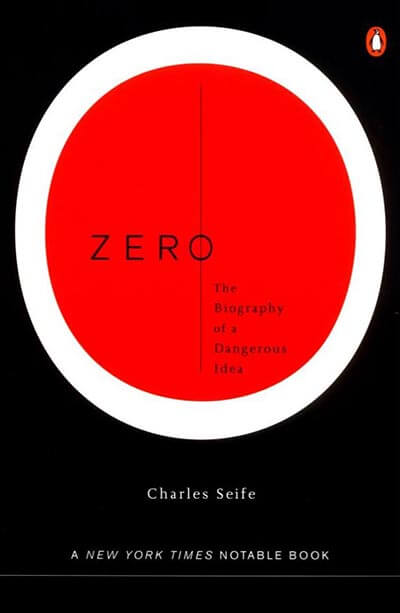
3 Sentence Summary
Charles Seife’s book “Zero: The Biography Of A Dangerous Idea” tells the captivating story of the number that was forbidden by the ancient Greeks and revered by the ancient Indians. The book explores how zero and infinity have been central to the fields of mathematics and philosophy for centuries. Its presented in a light-hearted manner through cleverly titled and subtitled chapters, making it an engaging read.
Summary Read Time: Less than 6 minutes
Actual Book Length: 248
First Published in: 2000
Key Ideas from The Book:
- The emergence of zero in ancient Babylonia marked its beginning in math.
- Despite its usefulness, ancient Greeks with philosophical inclinations dismissed the concept of zero.
- Zero was embraced by ancient Indian and Arabic mathematicians who made significant mathematical advancements.
- Theological Challenges of Embracing Zero Led to Calculus Revolution in the West.
- The Fascinating Correlation of Zero and Infinity
- From Math to Physics: The Significance of Zero and Infinity Is Undying
Below is the detailed yet quick summary of the book covering each idea:
Idea 1 – The emergence of zero in ancient Babylonia marked its beginning in math.
In the Stone Age, there was no need for zero as math was strictly functional, and people counted only what they needed. However, as time passed, math became more complex, and people began to develop advanced counting systems. The Babylonians were among the first to create a counting system that used a place value system. They used a sexagesimal counting system, which was in base 60, unlike the decimal system we use today.
The Babylonian counting system used just two symbols to represent 1 and 10. They repeated these symbols to represent bigger numbers, causing ambiguity with numbers like 61 and 3,601. To overcome this problem, the Babylonians created a new symbol – zero.
Zero was initially used as a placeholder denoting an absence, but it would later prove to be a powerful tool in unlocking new ideas and theories in mathematics. The discovery of zero enabled the development of algebra, calculus, and other branches of mathematics that we use today.
Idea 2 – Despite its usefulness, ancient Greeks with philosophical inclinations dismissed the concept of zero.
The ancient Greeks saw numbers as more than just counting tools, but as a philosophy. Mathematician-philosophers believed there was a harmony of numbers in every shape. However, the Greeks rejected zero, with Aristotle believing it didn’t exist and was just a product of the imagination. This belief was widely accepted in the Western world, to the detriment of math.
Zeno’s paradox questioned this belief when he devised a paradox about Achilles and a tortoise. Achilles could never overtake the tortoise because the Greek mathematical system couldn’t account for the gap between them, which was zero. Zero and infinity didn’t exist in the Greek mathematical system. This belief was the bedrock of their system and was influential through the Middle Ages in the West.
Aristotle’s influence was not as strong in the East, where they did not deny the existence of zero and infinity. The denial of these numbers was a mistake, as the paradox showed the existence of zero in the mathematical system.
Idea 3 – Zero was embraced by ancient Indian and Arabic mathematicians who made significant mathematical advancements.
The ancient Indians and Arabic mathematicians embraced zero and infinity as key concepts while ancient Greeks rejected them altogether. The ancient Indian mathematicians realized that zero deserved a place among the numbers, and it opened up new mathematical opportunities.
Unlike the Greeks, the ancient Indians thought of numbers in abstract terms, allowing them to solve equations involving negative numbers and abstract concepts. When these mathematical advances reached Muslim, Jewish, and Christian thinkers, it challenged their worldviews, but eventually, they all adopted these new concepts.
Italian merchants played a role in introducing the Arabic system of counting with ten digits, including zero, to the West in the Middle Ages. However, even some of the greatest mathematical minds treated zero with suspicion. For the ancient Indians, the concept of zero and infinity were important parts of their belief system, and it helped them make significant mathematical strides.
Idea 4 – Theological Challenges of Embracing Zero Led to Calculus Revolution in the West.
René Descartes, a prominent mathematician and philosopher, was hesitant to embrace zero despite lending his name to the Cartesian coordinate system that required zero to function properly. However, later mathematicians embraced zero and made groundbreaking discoveries in calculus, which is closely tied to zero and infinity.
Calculus allows mathematicians to calculate the area under curves, but to achieve accurate results, they must use an infinite number of rectangles, each with an area of zero. This method initially troubled many people who believed it was faith-based and not fully understood.
Jean Le Rond d’Alembert later resolved this issue by using limits to explain the concept of approaching a finite limit despite stretching towards infinity. Through this, zero became an integral part of Western mathematics, leading to significant advances in calculus and other mathematical fields.
Idea 5 – The Fascinating Correlation of Zero and Infinity.
Quadratic equations can be tricky and imaginary numbers like i and -i don’t exist. But when mathematicians started allowing for imaginary numbers, they discovered a fascinating relationship between zero and infinity. By mapping complex numbers onto a Cartesian grid, mathematicians discovered that the Riemann sphere makes it easier to understand equations like y = 1/x. On the sphere, the curve simply reaches the topmost point instead of shooting out of the picture towards infinity.
Bernhard Riemann realized that it made more sense to visualize things on a sphere. The sphere has i at one point and -i directly across from it with 1 and -1 perpendicular to them. And what goes at the top and bottom points of the sphere? Zero and infinity. The strange logic of math with complex numbers reveals that zero and infinity are equal and opposite poles, just like 1 and -1.
While this all might seem theoretical, zero and infinity are key to not only math but also physics.
Idea 6 – From Math to Physics: The Significance of Zero and Infinity Is Undying.
Zero and infinity are not just mathematical concepts; they are present in the real world and have helped underpin the advances made in physics.
Lord Kelvin discovered that it is impossible to cool an object below around -273 degrees Celsius, which is known as absolute zero. However, it is impossible to ever reach absolute zero since there are always particles around giving off energy and warming things up again. On the other hand, black holes have a mass but take up zero space. This causes a curve in space-time itself, sucking in anything that approaches it.
String theory, which claims that the universe exists in ten or eleven dimensions, almost bans zero. It says its not certain that what seems like zero to us may not really be zero when all the other dimensions are factored in. The theory helps explain certain enigmatic features about the universe, but some argue that this is more philosophy than true science because it’s not provable through experimentation.
From the beginning of time to the eventual end of the universe, zero has always exerted a mysterious, vacuous power. Although the concept of nothing is difficult to comprehend, it has some strange, mystical properties. Mathematicians and physicists alike are still uncovering the many ways in which zero and infinity have a complex but enthralling relationship with the real world.





